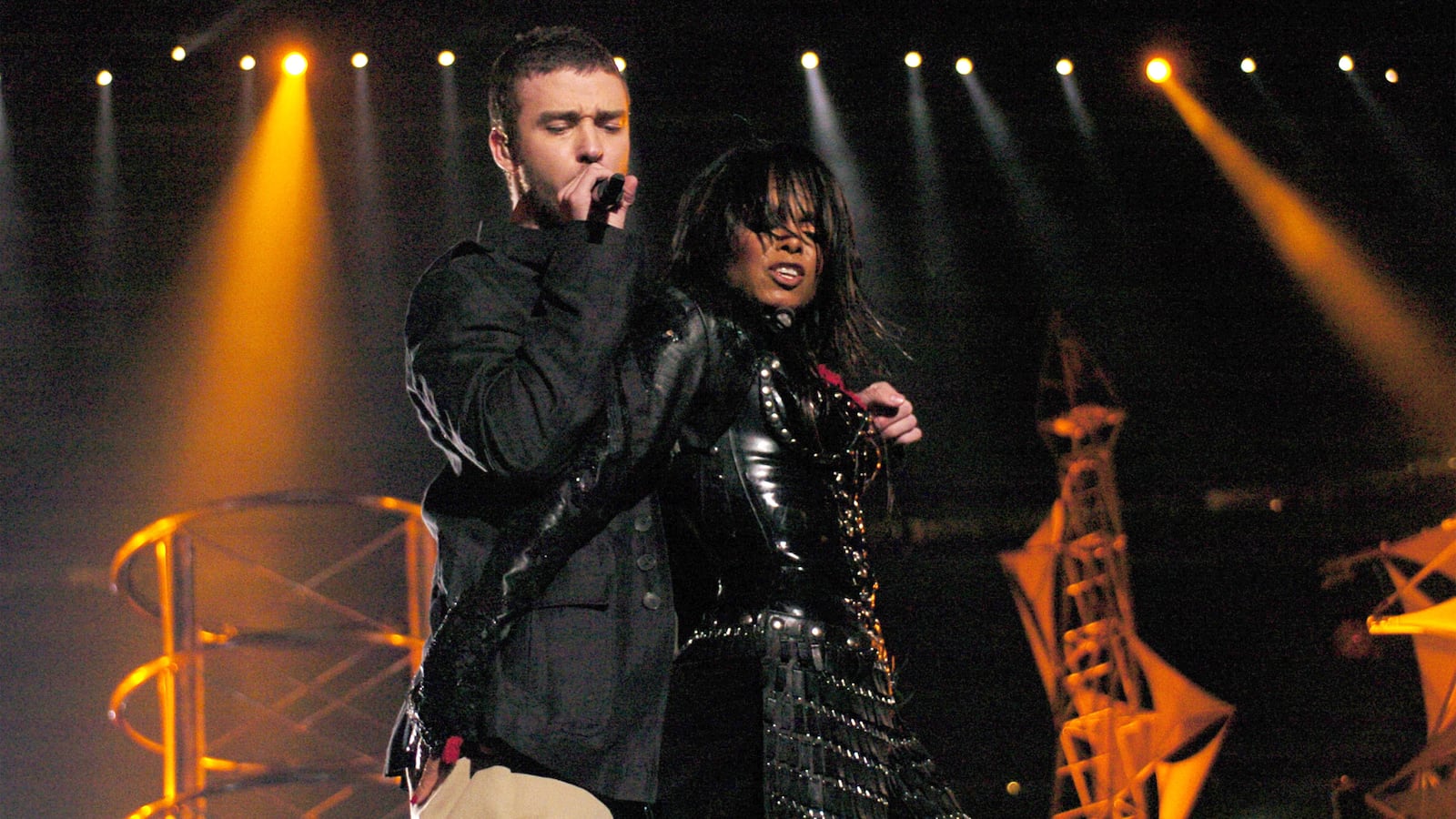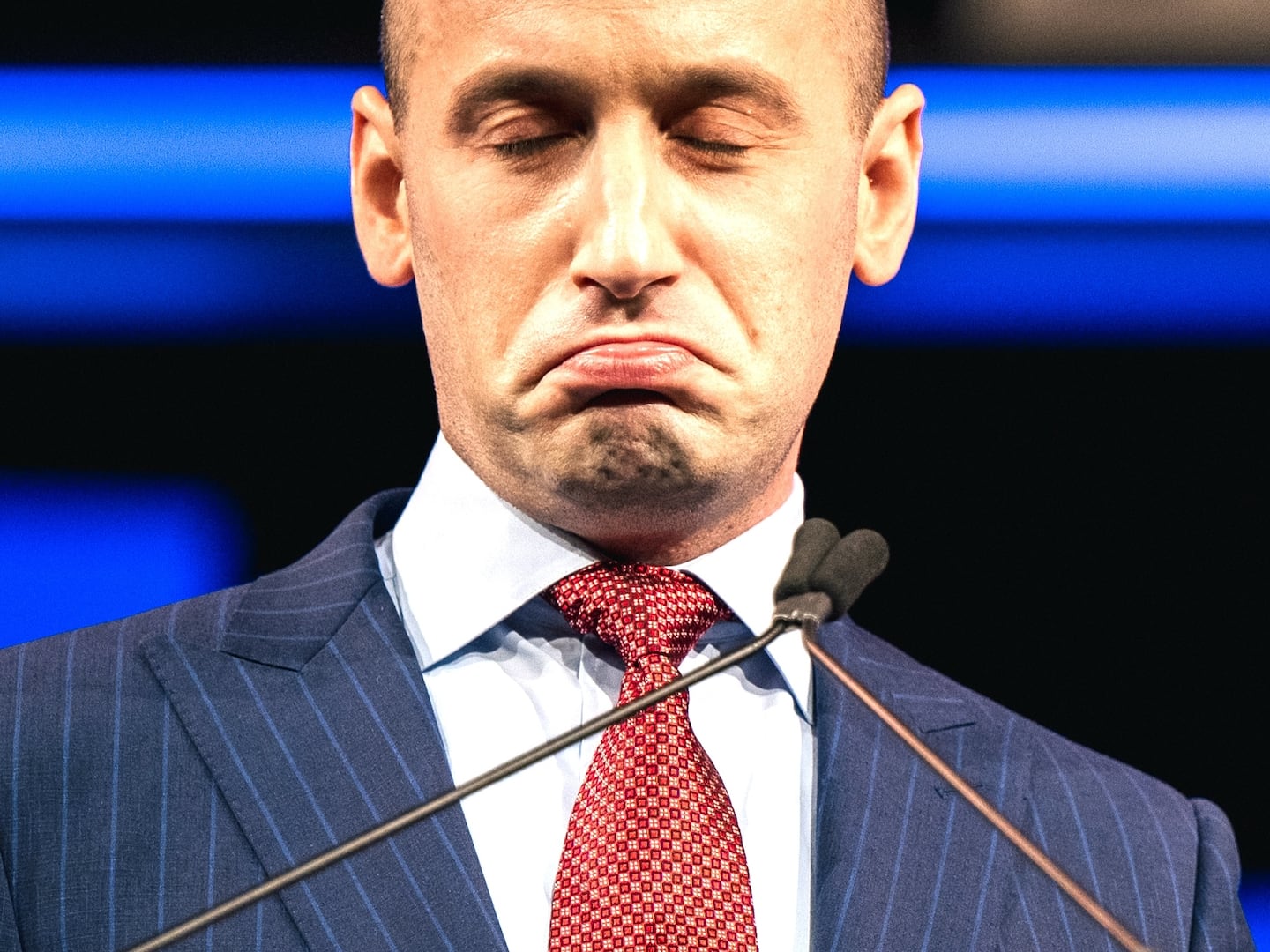It’s not new information that, in the past, Justin Timberlake has maybe, probably, most definitely been an absolute piece of shit. But a little reminder never hurts.
Of course, Malfunction: The Dressing Down of Janet Jackson is more than a little reminder. It’s “little” in the way that Janet Jackson’s breast being exposed on camera for 9/16th of one second during the 2004 Super Bowl caused a “little” fuss—or, as one pundit in the new documentary suggests, “If the culture wars could have a 9/11, it’s February 1, 2004.” That kind of reminder.
The latest installment of FX and Hulu’s The New York Times Presents series, Malfunction, which will be available starting Friday, follows the one-two punch of Framing Britney Spears and Controlling Britney Spears, two explosive documentaries that collided with a cultural movement and contributed to the end of the pop star’s allegedly abusive conservatorship after 13 years.
Amidst the revelations in that pair of films was a reassessment of Timberlake’s behavior at the time of his very public breakup with Spears two decades ago. In other words—sorry to say it again—how he was an absolute piece of shit.
Framing Britney Spears, for example, portrayed how the NSYNC breakout star used the media apparatus and our society’s default to misogyny to ruin Spears’ reputation and, in turn, elevate his career. He slut-shamed a person with whom he had sexual history and parlayed the points “scored” from being with her, a hot and famous woman who was rumored to be a virgin, into both sympathy points after a breakup and cool-dude fistbumps for his conquest, all to help his rise in the industry. Meanwhile, we were beatboxing along to his idiot song like giddy accomplices. (This is all also on us!)
You might say this is a piling on when it comes to Timberlake’s involvement in Y2K-era controversies, finally clarifying his behavior for what it actually was: opportunistic and degrading. Another documentary is coming out that applies the same scrutiny in relation to another major media story—the rare celebrity news event that dictated a generation’s worth of discourse, messaging, and even legislation. Does he deserve it? (Are you shaking your head “yes?”)
Who we are as a society is determined not just by what happened, be it with Spears or on that Super Bowl stage, but because of how he handled the aftermath. It’s our fault and it’s his fault. We set up the systems that made it easy for a man to pass the blame and benefit from it. And he took advantage of that. Now it’s time for reconsideration. For justice. To interrogate the lunacy of a “malfunction,” and understand what people did, who was held accountable, and why it exposes the worst about not just them, but us.
To reiterate: this is not new information. It took years, but there was enough of a groundswell of outrage over Timberlake’s agency in the media assassination of both Spears and Jackson that he, to his credit (however much of that you’d like to award him), finally took ownership of his part in the destruction of their careers in the name of boosting his own.
In the wake of Framing Britney Spears, which had pop-culture obsessives ready to fire up the barbecue and skewer him over the indisputable evidence of his complicity in the oppressive, predatory systems that contributed to Spears’ mental break, Timberlake recognized a reckoning. A reckoning that was happening over him.
The fact that Spears and Jackson are so linked when talking about these institutionalized aggressions isn’t a coincidence, just like it isn’t a coincidence that he took advantage of misogynoir to absolve himself of culpability and, more, augment his own fame.
“I’ve seen the messages, tags, comments, and concerns and I want to respond. I am deeply sorry for the times in my life where my actions contributed to the problem, where I spoke out of turn, or did not speak up for what was right. I understand that I fell short in these moments and in many others and benefited from a system that condones misogyny and racism,” he wrote in an Instagram post.
“I also feel compelled to respond, in part, because everyone involved deserves better and most importantly because this is a larger conversation that I wholeheartedly want to be part of and grow from,” he wrote. “The industry is flawed. It sets men, especially white men, up for success. It’s designed this way. As a man in a privileged position, I have to be vocal about this. Because of my ignorance, I didn’t recognize it for all that it was while it was happening in my own life but I do not want to ever benefit from others being pulled down again.”
In the post he wrote, “I specifically want to apologize to Britney Spears and Janet Jackson both individually, because I care for and respect those women and I know I failed.”
So let’s talk about how he failed Janet Jackson.
Malfunction: The Dressing Down of Janet Jackson is a peculiar documentary. Like Framing Britney Spears, it is most successful as a speed-read, an almost bullet-pointed rundown of the controversy at hand. Without the clear and brisk context that Framing Britney Spears gave to the conservatorship she was under and the theories as to why it might have been abusive, I’m not sure the progress that has happened in her case would have ever come to fruition.
Likewise, Malfunction offers as close to a tick-tock of what likely happened the night of that fateful Super Bowl halftime show in 2004 as we’re going to get. The event’s producers, CBS and MTV executives, and those in Congress and the lobbyist world who were hellbent on eviscerating Janet Jackson are all interviewed. Security camera footage insinuating what might have been a rogue decision to alter Jackson’s wardrobe is included.
The amount of gratification you receive from watching Malfunction depends on what your goal might be. Framing Britney Spears, for example, was an excellent tutorial on the major news story. As far as actual, verifiable accusations of impropriety, or the voice of Spears herself? It lacked both. Similarly, Malfunction presents a timeline and an engaging reconsideration of a cultural discourse. But the most pressing voices—Jackson’s and Timberlake’s—are missing.
That said, there’s an immense amount of gratification to be had from the rewriting of history to how it should have been.
The documentary almost too much wants to vilify Timberlake. It shows footage of when NSYNC was booked to be the opening act for Jackson’s 1998 tour, zeroing in on Timberlake caressing a poster of Jackson. It includes clips of a 2001 MTV tribute to Jackson during which Timberlake and bandmate Chris Kirkpatrick present. Kirkpatrick lists off her accomplishments. Timberlake continuously interrupts, as a bit, with the phrase, “She’s fine.”
Sure, the idea is to underline how little respect one of the most magnificent artists in the world received from a noted collaborator, and that is fair. It might be heavy-handed. But it’s not hard to believe.
It’s probably important to understand the timeline of what happened to understand why Timberlake comes off so poorly in this documentary—and why Jackson deserves consideration.
This is where, at least from the point of view of a millennial who remembers this story metastasizing from “did that happen?” to “how did this happen?” to “this woman just destroyed morality, decency, and Christianity all in 9/16th of a second,” it’s gratifying.
According to interviews, there was one night of dress rehearsals for the 2004 halftime show. Jackson was the headliner. Diddy, Kid Rock, and Nelly were also a part of it, but MTV, which produced the show with CBS, was keeping Timberlake’s involvement a secret. Timberlake was also a concession, meant to appease the network, which was afraid that the lineup was too dangerous for family-friendly TV.
The night was supposed to end with a costume tear-away when, Timberlake dancing with Jackson, says the lyric, “I’m gonna have you naked by the end of this song.” But originally it was going to be a skirt that he ripped away to reveal a bodysuit. The producers all agreed it didn’t work. Jackson was reportedly fine with that.
The documentary then shows footage of her stylist, Wayne Scot Lukas, going out that night to local stores and procuring the jewelry that would eventually be spotted around Jackson’s nipple by every person who had Google in 2004. He also was spotted going to a tailor. According to the timeline provided by Malfunction, Timberlake flew into Texas with minutes to spare before the show, Jackson and her stylist asked for a private meeting, and then history happened. It’s assumed that in that meeting, the tear-away stunt was planned.
Within a half-hour, all of America saw Janet Jackson’s boob. Well, that’s if they even noticed it, which many people who literally directed and produced the show didn’t at first.
If you’ll recall, the entire performance ends with Timberlake singing “I’m gonna have you naked by the end of this song,” reaching over to Jackson, and tearing a breastplate off her costume. Immediately, Jackson’s naked breast, save for jewelry around the nipple, is seen.
According to the documentary, Jackson fled the stadium and flew back to Los Angeles. Timberlake was still there. When Access Hollywood said to him afterward, “Hey, man, you guys were getting pretty hot and steamy up there,” Timberlake replied, “Hey man, we love giving y’all something to talk about.” Then celebrity correspondent Maria Menounos interviewed him. “You got nasty with Ms. Janet and that was pretty cool,” she said. He gave a seductive eyebrow-raise to the camera and smirked: “Hey man, it’s every man’s dream.”
This boastfulness would be a far cry from the tail-between-his-legs act when asked to kiss the ring in order to keep his career.
Les Moonves, the now-disgraced CBS executive accused of sexual misconduct—who at one point was the most important person in show business—demanded apologies from both. Timberlake responded in kind, and multiple times. At first, he claimed that the reveal was only supposed to be of a brassiere. When he saw what actually happened, “I don’t feel like I need publicity like this. And I wouldn’t be involved with a stunt, especially something of this magnitude,” he said.
The night of the incident, he was all swagger. Suddenly it was sorry, and “not my fault.”
Meanwhile, Jackson was still silent. And that angered everyone. It angered Moonves. It angered the people who filed FCC complaints in record numbers. It angered Congress.
Jackson released one apology. It wasn’t enough. Then she released a second, more thorough one. That wasn’t enough. The Grammy Awards, which also aired on CBS, happened a week later. Jackson and Timberlake were both told they could only attend if they would deliver another public apology. Jackson did not attend. Timberlake did, and won an award, apologizing for any offense his involvement in the incident caused while accepting his trophy.

Janet Jackson performs on stage during the MTV EMAs 2018 at Bilbao Exhibition Centre on November 4, 2018, in Bilbao, Spain.
Stuart C. Wilson/GettyIt’s impossible to judge things in a vacuum, but in the aftermath of the show, Jackson’s new album tanked. Of course it did. Even at a moment when we’re conditioned to understand how misogynistic we used to be, it is utterly shocking to see a supercut of the heinous, sexist, demeaning things that well-paid, supposedly enlightened pundits and talk-show hosts said about her at the time.
At that point, she was a movie star in addition to a music legend. She never booked a mainstream role again. Disney removed a statue that paid tribute to Rhythm Nation from the park. Meanwhile, McDonald’s solidified its deal with Timberlake. How can you not see the double standard? As most people in the documentary say, and as anyone with eyes can confirm, there were two people on that stage. And one of them ripped off the clothing.
Timberlake has been contrite. Yes, there was that Instagram post. It’s an apology. One that he’s made in the past. Malfunction includes a clip of him saying, “If you consider it 50/50, I probably got 10 percent of the blame. And I think that says something about society.”
That is… right. Are we ready to confront how outrageously we reacted at that time, for whatever cultural reasons, to Janet Jackson? I’m not sure.
Yes, the #JanetJacksonAppreciationDay movement, inspired when Timberlake was hired to perform again at the Super Bowl—my God, could there be a harsher indictment of straight white male privilege—may have led to the kind of support that allowed her Rock & Roll Hall of Fame induction to happen. And now she’s so mainstream again that, recently, Dancing With the Stars devoted an entire episode to her music.
But what was lost? That’s the thing we never consider. What was lost by our judgment? By our outsized outrage? By our eagerness to forgive Timberlake, the white man, and our reflexive instinct to vilify Jackson, a Black woman?
That’s the truth, though. There was something lost. What could our culture be if Jackson wasn’t silenced, diminished, and dismissed? If only we had some white guy to come and beatbox while we figure out the answer.







